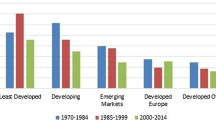Abstract
Using new series of aggregate and disaggregate output, this paper examines the historical pattern of volatility of economic fluctuations in Italy. Results evidence a higher stability in the postwar era, with respect to both the prewar and the interwar periods. Evidence is provided that the higher degree of stabilization of the Italian business cycle cannot be entirely attributed to the shift in the composition of aggregate output from more to less cyclical sectors. It is shown, however, that although the sign of the change in volatility is invariant to the filter adopted for the decomposition into trend and cycle, this is not true for both its size and statistical significance.
Similar content being viewed by others
References
Backus, D.K. and P.J. Kehoe (1992) “International Evidence on the Historical Properties of Business Cycles,”American Economic Review 4, 864–888.
Bartlett, M.S. (1937) “Properties of Sufficiency and Statistical Tests,”Proceedings of the Royal Society, series A, No. 160.
Bergman, M. and L. Jonung (1989) “Has the Business Cycle Been Dampened? The Case for Sweden and the United States,” Stockholm School of Economics, mimeo.
Burns, A. (1960) “Progress Toward Economic Stability,”American Economic Review 1, 1–19.
De Long, J.B. and L. Summers (1984) “The Changing Cyclical Variability of Economic Activity in the United States,” NBER Working Paper No. 1450, September.
Fuà, G. (ed), (1969)Lo sviluppo economico in Italia, vol. 3, Milan: Angeli.
Hodrick, R.J. and E.C. Prescott (1981) “Post-War U.S. Business Cycles: An Empirical Investigation,” Discussion Paper No. 451, Carnegie-Mellon University.
ISTAT (1957) “Indagine statistica sullo sviluppo del reddito nazionale dell'Italia dal 1861 al 1956,”Annali di Statistica, Rome.
ISTAT (1986)Annuario di Contabilità Nazionale, Rome.
ISTAT (1990)Nuova Contabilità Nazionale, Rome.
King, R.G. and S.T. Rebelo (1993) “Low Frequency Filtering and Real Business Cycles,”Journal of Economic Dynamics and Control 17, 207–231.
Kwiatkowski, D., P.C.B. Phillips, P. Schmidt, and Y. Shin (1992) “Testing the Null Hypothesis of Stationarity Against the Alternative of a Unit Root,”Journal of Econometrics 1, 159–178.
Mitchell, B.R. (1976)European Historical Statistics 1750–1970. New York: Columbia University Press.
Newey, W.K. and K.D. West (1987) “A Simple, Positive Semi-Definite Heteroskedasticity and Autocorrelation Consistent Covariance Matrix,”Econometrica 3, 703–708.
Perron, P. (1989) “The Great Crash, the Oil Price Shock, and the Unit Root Hypothesis,”Econometrica 6, 1361–1401.
Perron, P. (1990) “Testing for a Unit Root in a Time Series with a Changing Mean,”Journal of Business and Economic Statistics 2, 153–162.
Prescott, E. (1986) “Theory Ahead of Business Cycle Measurement,” Carnegie-Rochester Conference Series No. 25, 11–44.
Rappoport, P. and L. Reichlin (1986) “On Broken Trends, Random Walsk and Non-Stationary Cycles.” In M. Di Matteo, R.W. Goodwin, and A. Vercelli (eds),Technological and Social Factors in Long Term Fluctuations. Proceedings of a conference held in Siena. Berlin: Springer, pp.
Rappoport, P. and L. Reichlin (1989) “Segmented Trends and Non-Stationary Time Series,”Economic Journal 395, 168–177.
Reichlin, L. (1989) “Structural Change and Unit Root Econometrics,”Economics Letters 3, 231–234.
Romer, C.D. (1986) “Is the Stabilization of the Postwar Economy a Figment of the Data?”American Economic Review 3, 314–334.
Romer, C.D. (1989) “The Prewar Business Cycle Reconsidered: New Estimates of Gross National Product, 1869–1908,”Journal of Political Economy 1, 1–37.
Rossi, N., A. Sorgato, and G. Toniolo (1993) “Italian Historical Statistics: 1890–1990,”Rivista di Storia Economica 1, 1–47.
Schlitzer, G. (1995) “Testing the Stationarity of Economic Time Series: Further Monte Carlo Evidence,”Ricerche Economiche 49, 125–144.
Sheffrin, S.M. (1988) “Have Economic Fluctuations Been Dampened? A Look at Evidence Outside the United States,”Journal of Monetary Economics 21, 73–83.
Toniolo, G. (1990)An Economic History of Lilberal Italy 1850–1918. London: Routledge.
Vitali, O. (1992) “Gli implieghi del reddito nel 1911.” Inl conti economici dell'Italia. Una stima del valore aggiunto per il 1911, a cura di G. Rey, Rome.
Watson, M. (1994) “Business Cycle Duration and Postwar Stabilization of the U.S. Economy,”American Economic Review 1, 24–46.
Zarnowitz, V. and G.H. Moore (1986) “Major Changes in Cyclical Behavior.” In R.J. Gordon (ed),The American Business Cycle. Chicago: University of Chicago Press, pp.
Author information
Authors and Affiliations
Rights and permissions
About this article
Cite this article
Schlitzer, G. Have economic fluctuations been dampened? New empirical evidence from Italy. Open Econ Rev 6, 387–397 (1995). https://doi.org/10.1007/BF01000389
Issue Date:
DOI: https://doi.org/10.1007/BF01000389




